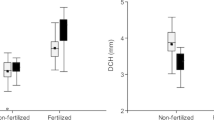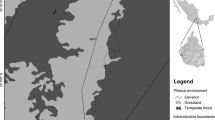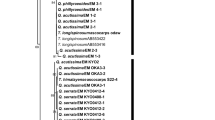Abstract
Stone pine (Pinus pinea) produces a highly demanded dried fruit, the pine nuts; Tuber borchii produces a well-known commercialized truffle. Thus, the co-culture of P. pinea and T. borchii may represents an interesting productive option. This work evaluated the effect of T. borchii inoculation on stone pine tree growth, survival, health, entry into cone production, and mycorrhization level during the first 3 years after establishment along a 2000 km gradient in Chile. We tested two treatments (inoculation and non-inoculation) in a multi-environment trial (MET) involving seven sites along Chile. Plantations were repeatedly measured during 3 years after establishment. In all environments, inoculation enhanced tree height, root collar diameter (RCD) and crown diameter (6.9, 10 and 8.3% higher for inoculated than for non-inoculated plants). Vigor was also favored (14.1% more vigorous trees). Stone pine performance was enhanced in all sites, but mainly in those with extreme environmental conditions. T. borchii mycorrhizae were abundant (over 60% of mycorrhized root apexes) 3 years after establishment. The truffle-host plant combination was not previously evaluated in Chile. The results showed high root colonization levels and the persistence of mycorrhization 3 years after establishment, and an enhanced effect of mycorrhization on tree growth and vigor under different soil and climate conditions, confirming the high plasticity of both species.





Similar content being viewed by others
Data availability
The datasets generated and analyzed during the current study are not publicly available due to institutional guidelines. They are available from the author upon request.
References
Agerer R (1996) Tuber borchii. In: Agerer R (ed) Colour Atlas of Ectomycorrhizae. Einhorn Verlag, Schwäbisch Gmünd
Angelini P, Stefanelli S, Granetti B, Bellini M (2004) Effetti della microrrizazione con Tuber aestivum Vittad. e con Tuber borchii Vittad. sull’accrescimento di piante di Pinus pinea L. Micol Ital 33:27–33
ASSAM (Agenzia Servizi Settore Agroalimentare delle Marche, Italy) (2004) Capitolato per la fornitura di Tuber. Pp 1.
Baciarelli Falini L, Benucci G, Bencivenga M, Donnini D (2012) Mycorrhization level in truffle plants and presence of concurrent fungi. Acta Mycol 47:169–173
Baglioni F, Gardin L, Marone E, Mazzei T, Nocentini G, Rizzo D, Zambonelli A (2016) I tartufi in Toscana, 2nd ed. Compagnia delle Foreste, 134 p
Bagnacavalli P, Capecchi M, Zambonelli A (2012) Con la certificazione la qualità è garantita. Emilia-Romagna, Italy
Belfiori B, Riccioni C, Paolocci F, Rubini A (2016) Characterization of the reproductive mode and life cycle of the whitish truffle T. borchii. Mycorrhiza 26:515–527. https://doi.org/10.1007/s00572-016-0689-0
Benucci GM, Bonito G, Baciarelli Falini L, Bencivenga M (2012) Mycorrhization of pecan trees (Carya illinoinensis) with commercial truffle species: Tuber aestivum Vittad. and Tuber borchii Vittad. Mycorrhiza 22(5):383–92. https://doi.org/10.1007/s00572-011-0413-z
Bledsoe C (1992) Physiological ecology of ectomycorrhizae: implications for field application. In: Allen MF (ed) Mycorrhizal functioning. Chapman and Hall, New York, pp 424–438
Bratek Z (2008) Mycorrhizal research applied to experiences in plantations of mycorrhizal mushrooms, especially in Central Europe. In: Mushroom biology and mushroom products. Proceedings of the Sixth International Conference on Mushroom Biology and Mushroom Products, Bonn, Germany, 29 September - 3 October, 2008. GAMU GmbH, Institut für Pilzforschung, Krefeld, pp 272–286
Callahan BJ, McMurdie PJ, Rosen MJ, Han AW, Johnson AJA, Holmes SP (2016) DADA2: high-resolution sample inference from Illumina amplicon data. Nat Methods 13(7):581–583
Cordero C, Cáceres P, González G, Quiroz K, Bravo C, Ramírez R, Caligari PDS, Carrasco B, García- Gonzales R (2011) Uso de marcadores moleculares para la detección rápida y precisa de trufa negra (Tuber melanosporum Vitt.) en plantas de vivero y plantaciones comerciales de Chile. Chilean J Agric Res. https://doi.org/10.4067/S0718-58392011000300022
Cortés-Sanchez M, Morales-Muñiz A, Simón-Vallejo MD, Lozano-Francisco MC, Vera-Peláez JL, Finlayson C, Rodríguez-Vidal J, Delgado-Huertas A, Jiménez-Espejo FJ, Martínez-Ruiz F, Martínez-Aguirre MA, Pascual-Granged AL, Bergadá-Zapata MM, Gibaja-Bao JF, Riquelme-Cantal JA, López-Saéz JA, Rodrigo-Gámiz M, Sakai S, Sugisaki S, Finlayson G, Fa DA, Bicho NF (2011) Earliest known use of marine resources by Neanderthals. PLoS ONE 6:e24026. https://doi.org/10.1371/journal.pone.0024026
Domíngez-Núñez JD, Planelles R, Barreal JR, de Omeñaca JS (2004) Influencia de la micorrización con trufa negra (Tuber melanosporum) en el crecimiento, intercambio gaseoso y nutrición mineral de plántulas de Pinus halepensis. Investig Agrar Sist y Recur for 13:317–327
Donnini D, Benucci GMN, Bencivenga M, Baciarelli Falini L (2014) Quality assessment of truffle-inoculated seedlings in Italy: proposing revised parameters for certification. For Syst 23:385–393. https://doi.org/10.5424/fs/2014232-05029
Dube F, Sotomayor A, Loewe MV, Müller-Using B, Stolpe N, Zagal E, Cabrera C (2015) Silvopastoral systems in temperate Chile. In: Dube F (ed) Silvopastoral systems in South America. Springer, Gainsville, pp 190–218
Evaristo I, Batista D, Correia I, Correia P, Costa R (2013) Chemical profiling of Portuguese Pinus pinea L. nuts and comparative analysis with P. koraiensis Sieb. & Zucc. commercial kernels. Options Méditérr 105:99–104
FIA (2009) Cultivo de trufa (Tuber melanosporum) en Chile. 38 p. Serie Experiencias de Innovación para el Emprendimiento Agrario. Proyecto de Innovación en la VII Región del Maule. Fundación para la Innovación Agraria (FIA), Talca, Chile
Garcia-Barreda S, Camarero JJ (2020) Tree ring and water deficit indices as indicators of drought impact on black truffle production in Spain. For Ecol Manage 475:118438. https://doi.org/10.1016/j.foreco.2020.118438
Garcia-Barreda S, Camarero JJ, Vicente-Serrano SM, Serrano-Notivoli R (2020) Variability and trends of black truffle production in Spain (1970–2017): linkages to climate, host growth, and human factors. Agric For Meteorol 287:107951. https://doi.org/10.1016/j.agrformet.2020.107951
Giraud M (1988) Prélèvement et analyse de mycorhizes. Bull FNPT-CTIFL (la Truffe) 10:49–63
Gómez-Romero M, Lindig-Cisneros R, Villegas J (2019) Performance of two valuable species, Pinus pseudostrobus and Eysenhardtia polystachya, in a low fertility soil mediated by mycorrhizal fungi and fertilization. Agrofor Syst 93:2027–2036. https://doi.org/10.1007/s10457-018-0305-8
Gregori G, Sisti D, Giomaro G, Rocchi M, Zambonelli A, Romagnoli E (2008) A new perspective in controlling Tuber infected plants: the use of ROC curves male applicable a visual estimation. 3th International Congress on Truffles. Spoleto, Italy, 25–28 November. Pp 80. https://www.montagneaperte.it/blog/atti-3-congresso-internazionale-sul-tartufo-di-Spoleto-2008-cdrom/
Hall I, Fitzpatrick N, Miros P, Zambonelli A (2017) Counter-season cultivation of truffles in the Southern Hemisphere: an update. Ital J Mycol. https://doi.org/10.6092/issn.2531-7342/6794
Harley J, Smith S (1983) Mycorrhizal symbiosis. Academic Press, London
Holman G (2020) Pine nut production in Australia. Australian Nut Industry Council. https://nutindustry.org.au/LiteratureRetrieve.aspx?ID=168689 Accessed 10 May 2020
INC (2020) International nut and dried council. Stat Rev: Pine Nuts Nutfruit 79:82–82
INC (2019) Nuts & Dried Fruits Statistical Yearbook 2019/20. International Nut and Dried Fruit Council. Reus. 80 p
Incredible (2021) Detected research needs for non-wood forest products in the Mediterranean. https://www.incredibleforest.net/sites/default/files/resource/files/incredible_detected_research_needs_for_nwfp.pdf Accessed 10 March 2022
Iotti M, Piattoni F, Leonardi P, Hall R, Zambonelli A (2016) First evidence for truffle production from plants inoculated with mycelial pure cultures. Mycorrhiza 26:793–798. https://doi.org/10.1007/s00572-016-0703-6
Kaounas V (2020) Edible below ground fungal fruit bodies in Greece. incredible innovation network for cork, resin & edibles, factsheet 20471.
Lakatos F, Mirtchev S (2014) Manual for visual assessment of forest crown condition. FAO, 17 p
Lancellotti E, Iotti M, Zambonelli A, Franceschini A (2016) The Puberulum Group Sensu Lato (Whitish Truffles). In: Zambonelli A, Iotti M, Murat C (eds) True truffle (Tuber spp.) in the World. Springer International Publishing, Switzerland, pp 105–124
Leonardi P, Iotti M, Donati Zeppa S, Lancellotti E, Amicucci A, Zambonelli A (2017) Morphological and functional changes in mycelium and mycorrhizas of Tuber borchii due to heat stress. Fungal Ecol 29:20–29. https://doi.org/10.1016/J.FUNECO.2017.05.003
Loewe V, Balzarini M, Álvarez A, Delard C, Navarro-Cerrillo R (2016) Fruit productivity of Stone pine (Pinus pinea L.) along a climatic gradient in Chile. Agric for Meteorol 223:203–216. https://doi.org/10.1016/j.agrformet.2016.04.011
Loewe V, Alvarez A, Balzarini M, Delard C, Navarro-Cerrillo R (2017) Mineral fertilization and irrigation effects on fruiting and growth in stone pine (Pinus pinea L.) crop. Fruits 72:281–287. https://doi.org/10.17660/th2017/72.5.3
Loewe-Muñoz V, Noel D (2021) Mediterranean Pinus pinea L. nuts from Southern Hemisphere provenances. Rend Lincei Sci Fis e Nat 32:181–189. https://doi.org/10.1007/s12210-021-00980-8
Loewe-Muñoz V, Del Río R, Balzarini M (2020a) Stone pine (Pinus pinea) growth and cone yield as a function of planting density in Chile. Bosque 41:381–386. https://doi.org/10.4067/S0717-92002020000300381
Loewe-Muñoz V, Delard C, Del Río R, Balzarini M (2020b) Long-term effect of fertilization on stone pine growth and cone production. Ann For Sci 77:69. https://doi.org/10.1007/s13595-020-00978-6
Loewe-Muñoz V, Del Río R, Delard C, Balzarini M (2022) Enhancing Pinus pinea cone production by grafting in a non-native habitat. New For 53:37–55. https://doi.org/10.1007/s11056-021-09842-5
Loewe-Muñoz V, Del Río R, Delard C, Balzarini M (2021) Short-term stem diameter variations in irrigated and non-irrigated stone pine (Pinus pinea L.) trees in a xeric non-native environment. Ann For Sci 78:99. https://doi.org/10.1007/s13595-021-01114-8
Lutz M, Loewe V, Zuleta A (2017) Comparative study of the chemical composition of pine nuts grown in six countries. In: IUNS 21st International Congress of Nutrition (ICN), 15–20 October 2017. Buenos Aires, Argentina
Martínez T, Santamargarita J, Barriga J (2004) Experiencias de micorrización en viveros forestales de la Junta de Extremadura. Foresta 27:152–156
Morcillo M, Sánchez M, Vilanova X (2015) Cultivar Trufas, una realidad en expansión. Barcelona, Spain
Murat C (2015) (2015) Forty years of inoculating seedlings with truffle fungi: past and future perspectives. Mycorrhiza 25:77–81. https://doi.org/10.1007/s00572-014-0593-4
Mutke S, Gordo J, Chambel MR, Prada MA, Álvarez D, Iglesias S, Gil L (2010) Phenotypic plasticity is stronger than adaptive differentiation among Mediterranean Stone pine provenances. For Syst 19(3):354–366
Nakashima H, Eguchi N, Uesugi T, Yamashita N (2016) Effect of ectomycorrhizal composition on survival and growth of Pinus thunbergii varying in resistance to the pine wilt nematode. Trees 30:475–481
Nergiz C, Dönmez I (2004) Chemical composition and nutritive value of Pinus pinea L. seeds. Food Chem 86:365–368. https://doi.org/10.1016/j.foodchem.2003.09.009
Olivera A, Bonet JA, Oliach D, Colinas C (2014) Time and dose of irrigation impact Tuber melanosporum ectomycorrhizal proliferation and growth of Quercus ilex seedling hosts in young black truffle orchards. Mycorrhiza 24:73–78
Ori F, Leonardi M, Puliga F, Lancellotti E, Pacioni G, Iotti M, Zambonelli A (2023) Ectomycorrhizal fungal community and ascoma production in a declining tuber borchii plantation. J Fungi 9:678. https://doi.org/10.3390/jof9060678
Pardos M, Calama R (2018) Responses of Pinus pinea seedlings to moderate drought and shade: is the provenance a differential factor? Photosynthetica 56:786–798. https://doi.org/10.1007/s11099-017-0732-1
Ramírez R, Henriquez R, Reyna S, Suàrez R, Webber C (2011) Cultivo de trufa negra en Chile. In: Reyna (ed) Truficultura: fundamentos y técnicas. Mundi Prensa, Madrid
Di Rienzo J, Casanoves F, Balzarini M, Gonzalez L, Tablada M, Robledo C (2022) InfoStat version 2022. http://www.infostat.com.ar. Accessed 10 January 2022
Rincón A, Alvarez IF, Pera J (2001) Inoculation of containerized Pinus pinea L. seedlings with seven ectomycorrhizal fungi. Mycorrhiza 11:265–271. https://doi.org/10.1007/s005720100127
Salerni E, Perini C, Gardin L (2014) ) Linking climate variables with Tuber borchii sporocarps production. Nat Resour 05:408–418. https://doi.org/10.4236/nr.2014.58038
Sen F, Ozer K, Aksoy U (2016) Physical and dietary properties of in-shell pine nuts (Pinus pinea L.) and kernels. Am J Exp Agric 10:1–9. https://doi.org/10.9734/AJEA/2016/22464
Stroup W (2012) Generalized linear mixed models: modern concepts, methods and applications. CRC Press, Florida
Le Tacon F (2021) Impact of irrigation and fertilization on Black truffle (T. melanosporum) fructification. Incredible Innovation Network for Cork, Resin & Edibles, Factsheet 19962
Vanhanen L, Savage G (2013) Mineral analysis of Pine nuts (Pinus spp.) grown in New Zealand. Foods 2:143–150. https://doi.org/10.3390/foods2020143
White TJ, Bruns TD, Lee SB, Taylor JWT (1990) Amplification and direct sequencing of fungal ribosomal RNA genes for phylogenetics. In: Innis MA, Gelfand DH, Sninsky JJ, White TJ (eds) PCR protocols: a guide to methods and applications. Academic Press, New York
Yin D, Song R, Qi J, Deng X (2018) Ectomycorrhizal fungus enhances drought tolerance of Pinus sylvestris var. mongolica seedlings and improves soil condition. J For Res 29:1775–1788. https://doi.org/10.1007/s11676-017-0583-4
Zambonelli A, Iotti M, Rossi I, Hall I (2000) Interactions between Tuber borchii and other ectomycorrhizal fungi in a field plantation. Mycol Res 104:698–702. https://doi.org/10.1017/S0953756299001811
Zambonelli A, Iotti M, Giomaro G, Hall I, Stocchi V (2002) T. borchii cultivation: an interesting perspective. In: Hall I, Wang Y, Danell E, Zambonelli A (eds) 2nd international workshop on edible ectomycorrhizal mushrooms. New Zealand Institute for Crop and Food Research, Christchurch, New Zealand
Acknowledgements
The authors thank Dr. Davide Sisti from Urbino University, Italy, for assisting in seedling mycorrhization certification in nursery, and Jorge González from INFOR, for assisting with molecular authentication procedures.
Funding
Trial establishment and measurements were funded by the Foundation for the Agriculture Innovation (FIA) [Development of a combined truffle and stone pine nut productive model, profitable productive alternative in a scenario of increasing hydric restrictions, PYT-2016-0038]. Analyses were funded by the Chilean Ministry of Agriculture [Development and contributions for the use of high value forest and fruit-forest species for Chile, INFOR] and by ANID BASAL FB210015.
Author information
Authors and Affiliations
Contributions
VL wrote most of the paper. CD directed the project that funded the study, and designed the study along with MB, GG and VL. CD was in charge of measurements and field activities and contributed to the paper elaboration. RDR and MB performed the statistical analyses, elaborated figures and collaborated in information gathering and analysis. GG directed the inoculation and evaluation of mycorrhization and participated in the preparation of the paper. All authors discussed the results and implications, and commented on the manuscript at all stages.
Corresponding author
Ethics declarations
Competing interests
The authors declare no competing interests.
Conflict of interest
The authors declare that they have no conflict of interest.
Additional information
Publisher's Note
Springer Nature remains neutral with regard to jurisdictional claims in published maps and institutional affiliations.
Supplementary Information
Below is the link to the electronic supplementary material.
Rights and permissions
Springer Nature or its licensor (e.g. a society or other partner) holds exclusive rights to this article under a publishing agreement with the author(s) or other rightsholder(s); author self-archiving of the accepted manuscript version of this article is solely governed by the terms of such publishing agreement and applicable law.
About this article
Cite this article
Loewe-Muñoz, V., Delard, C., del Río, R. et al. Effects of Tuber borchii inoculation on Pinus pinea 3 years after establishment along a latitudinal gradient in the Southern Hemisphere. Agroforest Syst 98, 369–381 (2024). https://doi.org/10.1007/s10457-023-00915-2
Received:
Accepted:
Published:
Issue Date:
DOI: https://doi.org/10.1007/s10457-023-00915-2




